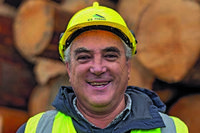
On a misty morning in June, Flight Logging’s Gordon Flight brought down the last tree in the Central North Island forests managed by NZ Forest Managers (NZFM) that had been damaged in February 2023 by Cyclone Gabrielle.
When Gordon set down the tree ready for extraction, it marked the end of an extraordinary 16-month salvage operation for NZFM and all the harvesting and trucking contractors that had helped with the work.
Not only did they manage to complete what would normally be six years’ worth of harvesting work in 16 months, they did it safely. In fact, NZFM’s safety statistics actually improved significantly during salvage work.
“From the outset there was plenty of discussion around having very clear objectives for the team during the salvage operation,” says NZFM General Manager, John Hura. “These were to minimise the value loss to our forest owners, and to do the work safely. That was driven both by the NZFM board, as well as our senior management team.”
When the cyclone hit, it damaged about 6,500 hectares of Central North Island forests, which equates to about 3.4 million cubic metres of wood – or some 13,000 rugby fields. Much of the damage was to the most valuable stands, those aged 20-years and older.
Salvaging the snapped and uprooted stems was a race against time because the longer they lay on the ground, the more they would degrade and lose value as sap stain and decay set in. It required NZFM to massively scale up its operations, and to do it quickly.
“To put it into perspective, we usually harvest about 1000 hectares of wood a year,” says NZFM Harvesting Manager, Matt Owen. “But the morning after the cyclone hit, we had 6,500 hectares of trees lying on the ground in Turangi. We needed to salvage that wood as quickly as possible before it deteriorated. So, essentially, we had to do six years’ worth of work in 16 months.”
Scaling up
In order to complete the salvaging operations, NZFM had to scale up its harvesting and trucking capacity by about five times, Mr Owen says.
“We went from about eight harvesting crews to about 41 at the peak of the work, and from about 100 truck movements a day to about 500.”
Scaling up that much, and so quickly, brought challenges.
“We had to onboard new harvesting and trucking contractors who weren’t familiar with our systems,” Mr Hura says. “We had to find more supervisory staff and admin staff. We had to bring in new systems to deal with the dispatching of so many trucks.”
Mr Owen adds, “We had several contractors and lots and lots of trucks using the same roads and working in close proximity to each other.”
There were also additional risks in harvesting windthrown wood, he says.
“It creates more risk. There’s hung up trees, broken trees, a lot more hazards on the ground left by holes from the root balls.”
Despite all these challenges, NZFM was able to...






